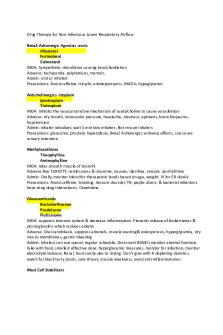Respiratory Drugs Table PDF

| Title | Respiratory Drugs Table |
|---|---|
| Course | Medicine |
| Institution | University of Dundee |
| Pages | 2 |
| File Size | 149.9 KB |
| File Type | |
| Total Downloads | 80 |
| Total Views | 140 |
Summary
Respiratory Drugs Table...
Description
Drug Class Bronchodilators (Releivers)
Sub Class
Types Short Acting (SABA)
Example Salbutamol
Mechanism of Action Stimulate bronchial smooth muscle B2adrenoceptors. ↑cAMP ↑PKA Relaxation Act rapidly (max effect 30 mins)
Used For 1st line for mild intermittent asthma (Reliever)
B2- adrenoceptors agonists
Long Acting (LABA)
Salmetarol
Stimulate bronchial smooth muscle B2adrenoceptors. ↑cAMP ↑PKA Relaxation NOT for acute relief Antagonise Cysteinyl leukotriene receptors. CysLTs (LTC4, LTD4 and LTE4) derived from inflammatory cells contraction of ASM, Oedema, ↑mucus, ↑eosinophils. Relax ASM. Low therapeutic ratio (good efficacy) Signal via nuclear receptors, bind to glucocorticoid response elements (GRE) gene transcription (↑anti-inflammatory, ↓inflammatory). ↓cytokines, prevent IgE antibody production, ↓mast cells, prevent allergen influx Direct into lung all the above effects where you want it Mast Cell Stabiliser (suppress histamine release), weak anti-inflammatory effect, reduction of cytokine release
Nocturnal Asthma Add on therapy (must be co-admin with glucocorticoid.) Asthma (antiinflammatory) Add on therapy. Used in Exercise induced Asthma
CysLT1 Receptor Antagonists
Antiinflammatory (controllers/preve ntors)
Corticosteroids (Glucocorticoids)
Cromones
IgE antibodies
Antiinflammatory and Bronchodilator
Montekulast Zafirlukast
Oral Steroid
Prednisolone
Inhaled Steroid Inhaled
Beclomethasone
Antiinflammatory anti-IgE monoclonal antibody
Omalizumab (Injection every 24 weeks v.expensive).
Inhibits the binding to high affinity IgE receptor and inhibits mediator release from basophils and mast cells. No effect on pulmonary function but ↓exacerbations.
Theophylline (oral)
Non-selective inhibition of phosphodiesterase (PDE). Inhibits PDE3 and increases cAMP in ASM relaxes ASM. Anti-inflammatory actions, inhibit mediator release from mast cells, increased mucus clearance. Non-selective PDE inhibitor (↑cAMP) relaxes ASM Ipratropium (non-selective blocker of M1, M2, M3 receptors. M3 muscarinic receptors mediate contraction of ASM.
Methylxanthines
Cromoglicate
Aminophyline (IV) Bronchodilators
Competitive muscarinic receptor antagonists (all given via inhalation)
Short Acting muscarinic antagonists (SAMAs)
Ipratropium Oxitropium
Asthma to suppress immune system (Step 5 treatment)
Side Effects When inhaled: fine tremor, tachycardia, arrhythmias, hypokalaemia.
Contraindications Use with caution in hyperthyroidism, CVS disease, arrhythmias and hypertension. NB: Do not prescribe non-selective beta blockers in asthma (bronchospasm).
Well tolerated. But headaches and GI upset reported e.g. abdo pain Oral Candidiasis, GI - peptic ulcer, MSK – myopathy, endocrine – Cushing’s
Asthma – maintenance therapy Prophylaxis in mild and exercise induced asthma not used much due to poor efficacy Prophylaxis in Asthma with raised IgE and severe persistant allergic asthma despite max therapy
Fewer systemic side effects v.little systemic absorption
Abdo pain, headache, pyrexia
Caution in autoimmune disease
Asthma (maintenance therapy)
P450 drug interactions e.g. erythromycin
Asthma (acute attacks)
Narrow therapeutic window and has adverse effects at toxic range (arrhythmias, seizures, hypotension)
COPD – palliative to reduce exacerbations. Or as LAMA/LABA combo. Or as triple therapy
High therapeutic ratio. Not well systemically absorbed
Long Acting Muscarinic Antagonists (LAMAs) Antiinflammatory Mucolytics
PDE4 inhibitors
Tiotropium Aclidinum
Tiotropium selective for M3. Longer ½ life than ipratropium.
ICS/LABA/LAMA. Short term relief.
therefore few side effects
Rofumilast (oral)
Selective PDE4 inhibitor. PDE4 = expressed in neutrophils, T cells and macrophages.
To reduce COPD exacerbations (additive to LABA or LAMA) Reduce sputum viscosity (Add on therapy)
Nausea, Diarrhoea/headac he/weight loss Rarely GI bleeding
Syptomatic treatment of acute exacerbations of chronic bronchitis
Very rarely; nausea, vomiting, diarrhoea, abdo pain
Oral Carbocisteine Oral Erdosteine
Caution: those with history of peptic ulcer Active peptic ulcer See above...
Similar Free PDFs

Respiratory Drugs Table
- 2 Pages

Chapter 37 Respiratory Drugs
- 6 Pages

Respiratory Pathology Table
- 22 Pages

Herpes drugs, anti cancer drugs
- 6 Pages

Respiratory Alkalosis
- 1 Pages

Respiratory system
- 8 Pages

Hemostasis drugs
- 5 Pages

Psychotomimetic drugs
- 7 Pages

Controlled Drugs
- 25 Pages

IR Table IR Table IR Table
- 6 Pages

Respirotory Drugs
- 3 Pages

Dopaminergic Drugs
- 2 Pages
Popular Institutions
- Tinajero National High School - Annex
- Politeknik Caltex Riau
- Yokohama City University
- SGT University
- University of Al-Qadisiyah
- Divine Word College of Vigan
- Techniek College Rotterdam
- Universidade de Santiago
- Universiti Teknologi MARA Cawangan Johor Kampus Pasir Gudang
- Poltekkes Kemenkes Yogyakarta
- Baguio City National High School
- Colegio san marcos
- preparatoria uno
- Centro de Bachillerato Tecnológico Industrial y de Servicios No. 107
- Dalian Maritime University
- Quang Trung Secondary School
- Colegio Tecnológico en Informática
- Corporación Regional de Educación Superior
- Grupo CEDVA
- Dar Al Uloom University
- Centro de Estudios Preuniversitarios de la Universidad Nacional de Ingeniería
- 上智大学
- Aakash International School, Nuna Majara
- San Felipe Neri Catholic School
- Kang Chiao International School - New Taipei City
- Misamis Occidental National High School
- Institución Educativa Escuela Normal Juan Ladrilleros
- Kolehiyo ng Pantukan
- Batanes State College
- Instituto Continental
- Sekolah Menengah Kejuruan Kesehatan Kaltara (Tarakan)
- Colegio de La Inmaculada Concepcion - Cebu



